Comprehensive Guide to Stone Carving Tools
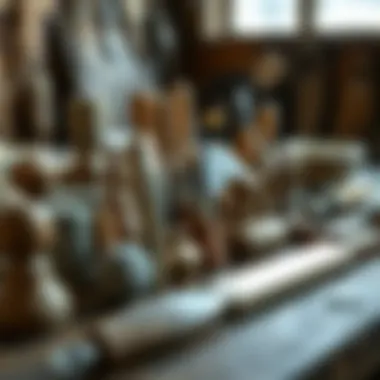
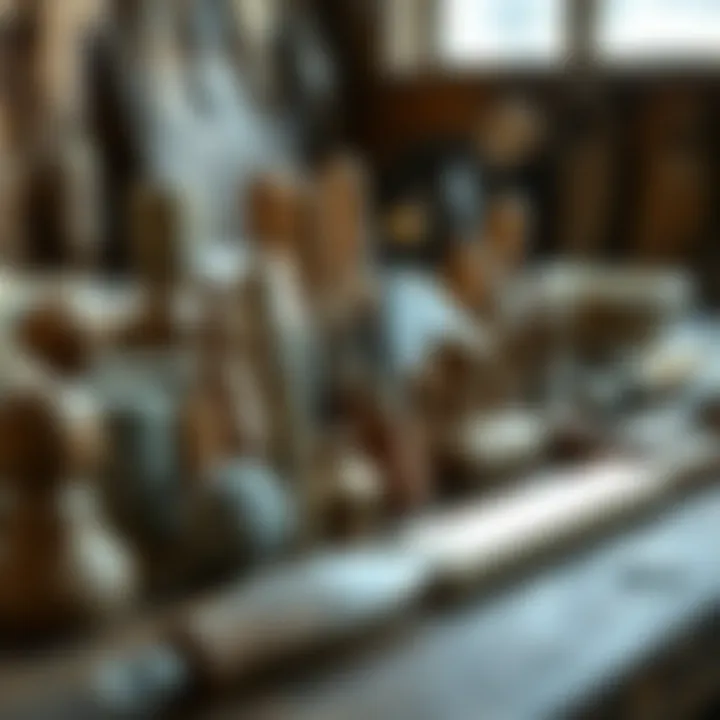
Intro
Stone carving is an ancient art, steeped in history and rich with cultural significance. Craftsmen and hobbyists today engage in this labor-intensive yet rewarding process, bringing to life intricate designs from raw materials sourced from the earth. Within this artistic endeavor, the tools of the trade play a pivotal role. Understanding the various stone carving tools and their suitable applications can elevate your skills and results.
In this exploration, we’ll travel through the origins and evolution of stone carving tools, discuss their diverse types and uses, and provide guidance on selecting and maintaining them. Additionally, insights gleaned from user feedback can help you make informed decisions, ensuring your investments in these tools will aid your creative pursuits effectively. Whether you are a seasoned carver or a newcomer eager to learn the lingo, this guide is crafted to meet your needs. Let's roll up those sleeves and delve deeper into the world of stone carving tools!
Prologue to Stone Carving
When it comes to the world of sculpting and artistry, stone carving stands out as a venerable craft that has stood the test of time. This ancient art form, believed to date back thousands of years, requires not only a creative spirit but also a deep understanding of the materials and tools involved. With a rich tapestry of history intertwined with modern-day applications, stone carving tools play a crucial role in bringing artistic visions to life.
Definition and History of Stone Carving
Stone carving refers to the process of shaping and sculpting stone using various tools. Traditionally, it involved chiseling, hammering, and polishing stones to create desired forms and figures. The earliest examples of this craft can be traced back to the ancient Egyptian and Mesopotamian civilizations, where artisans carved intricate designs into monuments and temples. As time wore on, different cultures adapted and evolved their methods. For instance, in Greece, stone carving was perfected in the creation of statues that portrayed the human body with such realism that they were almost lifelike.
Today, stone carving remains as relevant as ever. Modern carvers often embrace both traditional and contemporary techniques, blending centuries-old practices with new-age tools and technologies. It's a fascinating blend of art, history, and innovation.
Cultural Significance of Stone Carving
Stone carving is more than just a method of shaping rock; it's an important cultural touchstone that resonates across various societies. In many cultures, stone statues and monuments signify power, spirituality, and beauty. From the grand Easter Island Moai to the intricate Indian sculptures, each carving tells a story—often steeped in mythology or historical importance.
"The stones we carve may crumble in time, but the stories they hold are immortal."
Moreover, the craft is often passed down through generations, helping to preserve cultural identities and traditions. Many stone carvers see their work as not just a vocation but a stewardship of their heritage, ensuring that age-old techniques and stories continue to thrive and inspire future artists.
In this article, we will explore the tools that enable these remarkable creations, paying homage to the artistry behind each chisel mark and hammer strike, and shedding light on their practical applications to better equip both novice and seasoned stone carvers.
Overview of Carving Tools
When diving into the world of stone carving, understanding the tools at your disposal is critical. Tools are not just instruments; they are extensions of the artist's will and creativity. An improper selection or misuse of tools can lead to frustrating experiences and subpar results. Therefore,knowing different types of carving tools is essential not only for execution but also for crafting precise and intricate designs.
The right tools can pave the way for precision and efficiency, helping achieve that finely detailed work that is sought after in this art. From chisels that slice through rock to specialized tools designed for delicate carvings, the range is vast and varied. Each tool has its strengths and weaknesses, and knowing what to look for can make or break a project.
As we dissect the types and specialties of stone carving tools, it becomes clear that they are the backbone of any successful stone carver's toolkit. Not only do they greatly influence the quality of work, but they also allow artists to express their unique style and vision with greater ease.
Types of Stone Carving Tools
Chisels
Chisels are perhaps one of the most widely recognized tools in stone carving. They come in varied shapes and sizes, each tailored for specific types of cuts. The key characteristic of chisels is their ability to produce clean lines and fine details, making them indispensable for both beginners and seasoned professionals.
The versatility of chisels cannot be overstated. They can be used for roughing out forms or adding delicate detailing. However, a drawback lies in the need for skillful handling; improper usage can lead to mistakes that might require extensive rectification. In this article, it’s evident that having a solid chisel set is fundamental to kick start any stone carving venture.
Hammers
No stone carving toolset is complete without hammers. These are primarily used to drive chisels into the stone, making them a crucial partner. The distinctiveness of hammers lies in their construction and weight. Ideally, they should offer a balance that allows for controlled striking, which is crucial for detailing work.
A noteworthy advantage of hammers is that they enable the artist to exert higher force for the initial rough shaping of the stone. On the flip side, selecting a hammer that is too heavy can lead to fatigue, making it harder to maintain precision over longer periods. A well-chosen hammer is a game-changer in marking one's progress in stone carving.
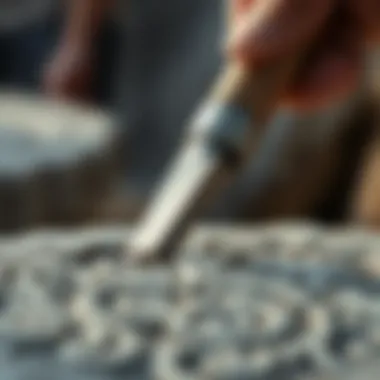
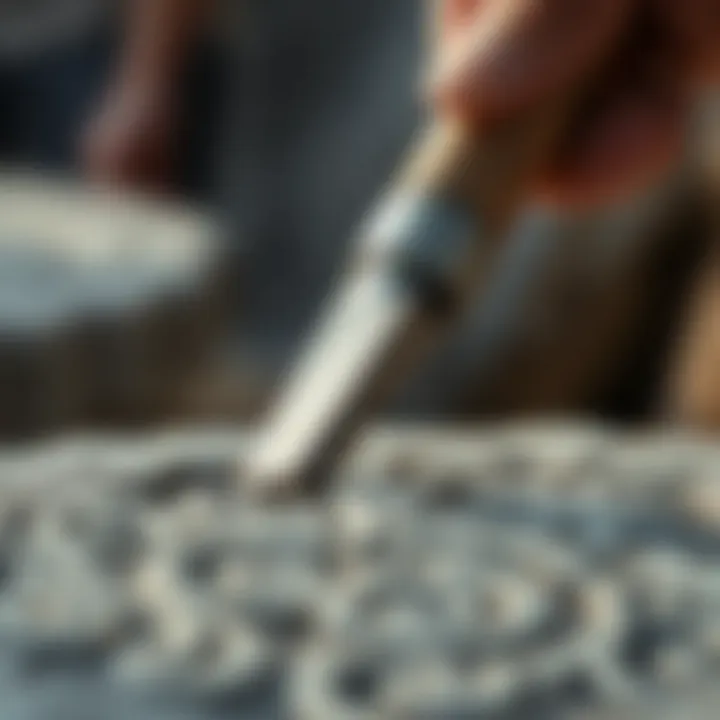
Rasps and Files
Then we have rasps and files, designed specifically for smoothing and refinishing surfaces. They play a significant role in achieving that sublime, soft finish that characterizes high-quality stone carving. The fine teeth of rasps allow for efficient shaping and refining, while files can be used for more delicate detail work.
What sets these tools apart is their ability to give a finished quality to stone sculptures. While they are generally used after the bulk shaping is done, some artists prefer to incorporate them earlier to tweak details. It's important to note, however, that using these tools requires patience, as overzealous application can lead to removing too much material. Striking the right balance is key.
Specialized Tools for Intricate Designs
Having a foundation of chisels, hammers, rasps, and files sets the stage for more intricate designs. Specialized tools have emerged, allowing artists to explore creativity on a granular level.
Rotary Tools
Rotary tools offer unmatched flexibility and precision. They are especially handy for fine, detailed work that regular chisels might struggle with. The high-speed rotation allows for rapid material removal, enabling artists to carve curves and intricate patterns effortlessly.
Among the many recognizable features of rotary tools is their versatility. These tools often come with various attachments suited for different tasks. A downside, however, is that they could create dust and debris, requiring protective measures. Nonetheless, for those aiming for precision on a small scale, rotary tools are second to none.
Point Tools
Point tools are a smaller, often overlooked category of stone carving tools, yet they hold significant value. These tools typically feature a tapered point that excels in detailing work and creating divisions in the stone. The unique shape enables carving fine lines and subtle textures that can elevate a piece.
A major benefit of point tools is their ability to reach tight spaces, making them indispensable for intricate projects. But, cautious use is necessary as excessive pressure can lead to an uneven finish. These tools are truly valuable for artists who enjoy embellishing their work with minute details.
Flat Tools
Finally, we have flat tools, which serve a distinct function in stone carving. Their broad edges are ideal for creating smooth surfaces and broader cuts. This makes them popular among artists looking to achieve a clean, polished finish on larger areas.
The unique feature of flat tools lies in their coverage capacity, reducing the time spent on shaping larger sections. However, skillful handling is crucial, as improper use might lead to flat edges that compromise the aesthetics of the artwork. It’s clear that flat tools are indispensable for certain projects but require tactful manipulation.
"Each tool tells a story; the sculptor's hand brings it to life."
Understanding these tools is essential for effective stone carving. Each serves a particular purpose and choosing the correct tool could very well make the difference between a meh sculpture and an amazing one. Selecting the right combination from these tools lays the groundwork for achieving the desired artistry.
Selecting Stone Carving Tools
Choosing the right tools for stone carving isn't just a matter of preference; it can make or break your entire woodworking experience. Selecting the appropriate tools means understanding how they will work with the materials at your disposal and the skills you possess. Each tool has its distinct role, and the right combination will help to bring your artistic vision to life while ensuring safety and efficiency. A well-informed choice lays down the foundation for creativity and success in stone carving.
Key Considerations for Tool Selection
Material Compatibility
When it comes to material compatibility, it’s like pairing wine with cheese; certain tools suit specific types of stone more effectively than others. For instance, softer stones like alabaster are easier to carve with lighter tools, while harder materials like granite require sturdier, high-carbon steel chisels. The main characteristic of material compatibility lies in how the tool interacts with the stone's structure. Choosing the right match allows for a smoother carving experience and less tool wear.
The unique feature of material compatibility is its role in managing wear and tear. Using the wrong tool can elevate the chances of breakage and affect the finish quality, which is a situation no carver wants to encounter. So, in this article, we emphasize considering the stone’s hardness and texture before making your selection—a beneficial approach that can save both time and frustration.
Tool Size and Weight
The size and weight of your tools can heavily influence your carving precision and comfort. Imagine trying to chip away at a dense marble block with a featherweight chisel. It's hardly feasible, right? A significant aspect of tool size and weight relates not just to the effectiveness but also to the carver’s ergonomic comfort. Getting tools that are proportionate to your hand size will help minimize fatigue and maximize control.
This choice also influences the detail outcome. Larger tools might be the go-to for roughing out shapes quickly, but they can be clumsy when it comes to intricate design work. Each carver’s experience will inform how comfortable they are with varying sizes, so it's wise to contemplate which dimensions feel best for your particular carving style.
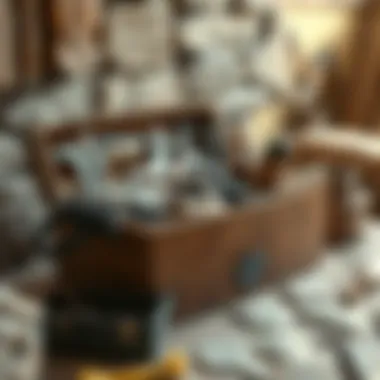

User Proficiency Level
The user's proficiency level shapes tool selection in a profound way. A novice might well approach the world of stone carving with limited experience, making it essential to start with tools that are easier to handle and forgiving of mistakes. A good pair of beginner-friendly chisels can be more advantageous than attempting to master advanced rotary tools right off the bat.
What’s fundamental here is that user proficiency doesn’t just determine what you can carve; it also dictates how comfortable you feel tackling larger or complex projects. Advanced carvers may favor tools that offer greater finesse, allowing them to showcase their skill. Having tools that align with your proficiency not only nurtures growth but can also reignite passion in your craft.
Shop Smart: Using Amazon for Tool Acquisition
Finding the right tools can feel like searching for a needle in a haystack. Thankfully, platforms like Amazon provide a hub for every kind of stone carver—whether you’re a seasoned artist or just starting out. Here, you can browse through an extensive range of options, compare prices, read reviews, and make informed decisions that suit your needs, all from the comfort of your home.
Top Stone Carving Tools on Amazon
When venturing into the world of stone carving, understanding the tools available is essential. This section highlights the best stone carving tools you can find on Amazon. These tools significantly enhance the carving experience, enabling hobbyists and collectors to bring their visions to life. Quality tools foster accuracy and ease in the carving process, and investing in reputable products can yield substantial benefits in the long run.
Popular Chisel Sets
Chisels serve as the backbone of any stone carving toolkit. They come in various shapes and sizes, each tailored for specific tasks. As such, choosing the right chisel set is crucial for achieving a desired result. Popular chisel sets on Amazon often include a range of tools featuring different blade widths and angles which helps in tackling detailed designs.
Many buyers appreciate sets that include specialized chisels like point chisels for rough shaping, flat chisels for smoothing, and even spoon chisels for creating curves. Look for sets made from high-quality steel that can withstand rigorous use without dulling quickly. A robust set usually contains around five to ten chisels, catering to both beginners and seasoned carvers alike. Reading customer reviews provides insight into the durability and performance of specific sets, allowing you to pick sets that have stood the test of time.
Highly Rated Hammers
A good hammer can make all the difference in stone carving. Available in various styles like point hammers, club hammers, and mallet hammers, each type serves a unique purpose. Highly rated hammers on Amazon have garnered attention for their weight, balance, and impact efficiency. Many experienced carvers recommend choosing hammers with comfortable grips to ensure precision during longer carving sessions.
In addition, the material of the hammer, whether it be steel or fiberglass, can influence the overall feel and effectiveness. Buyers should pay close attention to the weight of the hammer as well; a heavier hammer can drive the chisel deeper into the stone, while a lighter one offers more control for delicate work. Satisfied customers often note the importance of balance in a hammer, claiming it lends better control and reduces hand fatigue.
Recommended Rotary Tools
In the age of technology, rotary tools have revolutionized stone carving. These tools can accomplish a wide range of tasks, from rough shaping to intricate detailing, making them invaluable for modern carvers. On Amazon, several rotary tools have earned accolades for their versatility and efficiency. Most recommended models are lightweight and easy to maneuver, featuring variable speed settings that allow for precise adjustments based on the job at hand.
Rotary tools come equipped with various attachments, like diamond bits and grinding wheels, that make them suitable for everything from carving to polishing. When selecting a rotary tool, consider the ease of changing attachments, as this can affect workflow during a project. Many experienced stone carvers suggest opting for a kit that covers a good spectrum of attachments to maximize functionality. Check out reviews to gauge user satisfaction; tools that receive high praise usually indicate reliability and performance in a demanding environment.
Finding the right tools is as important as the skills you possess; together, they create art that resonates.
Overall, utilizing the right stone carving tools is crucial for achieving excellence in stone work. By investing in quality chisels, hammers, and rotary tools, aspiring stone carvers can effectively refine their craft and produce impressive work. Don't forget to check customer feedback to make informed purchasing decisions, ensuring that the tools you choose are worth every penny.
The Art of Tool Maintenance
Maintaining stone carving tools is not just a chore, it's an essential part of the craft. Just like a chef needs a sharp knife to slice through meat, a carver needs finely tuned tools for precision and effectiveness. Neglecting this aspect can lead to poor carving results and unnecessary frustration. For those who carry a passion for stone carving, understanding the nuances of maintenance, including cleaning, sharpening, and proper storage, elevates the art form.
Cleaning and Sharpening Techniques
Cleaning stone carving tools should not be overlooked. Dirt and grime can build up quickly, especially after lengthy sessions chiseling away at tough materials. Using a soft brush or cloth right after finishing your work can go a long way. Here's a simple routine you can follow:
- Rinse tools with water to remove dust.
- Use a mild soap if necessary; dish soap often does the trick without being too harsh.
- Dry immediately to prevent rust, especially on metal parts.
Sharpening the tools is another crucial phase that needs to be done with care. A sharp chisel will glide through stone, while a dull one will leave you with nothing but frustration. Here’s how to keep your chisels razor-sharp:
- Use a whetstone at 1000 to 4000 grit for precision.
- Always wet the stone before use to avoid overheating.
- Maintain the angle of about 20 degrees against the stone for an effective sharpen.
- Regular honing can keep your edges crisp and prevent the need for more significant sharpening sessions.
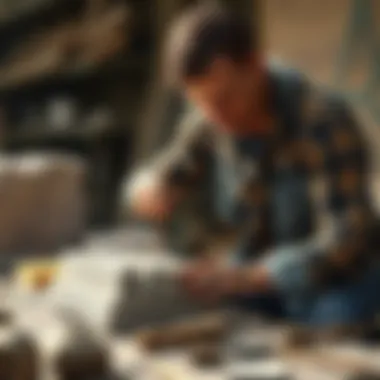
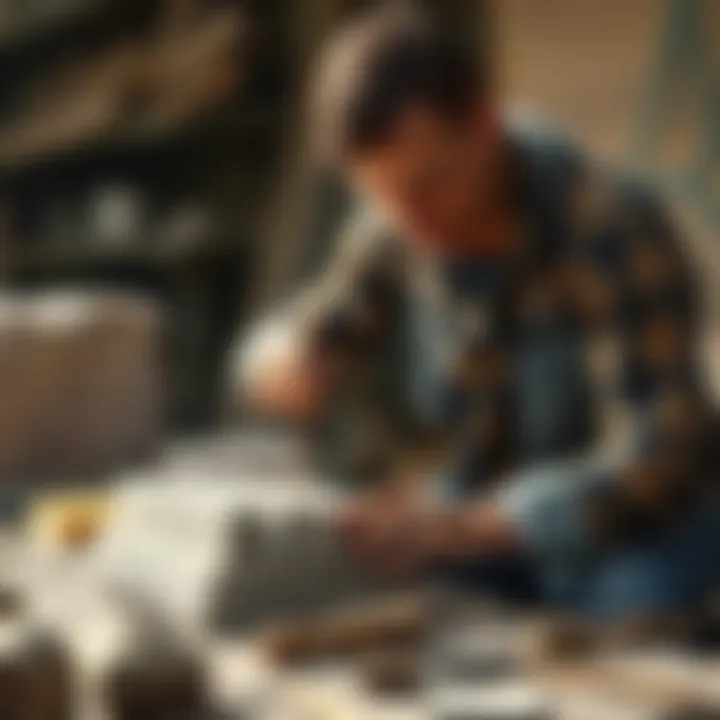
Remember, it’s easier to maintain a tool than to restore one that has been neglected. Regular attention is well worth the time.
Storage Solutions for Longevity
After putting so much effort into maintaining your tools, proper storage becomes key to their longevity. Storing tools incorrectly can result in nicks, rust, and wear. Here’s a compilation of considered practices for optimal storage:
- Toolboxes: Opt for a sturdy toolbox that offers individual compartments. This helps in keeping tools separated to minimize contact that can cause wear.
- Magnetic Strips: Installing magnetic strips on walls not only saves space but also allows you to see every tool at a glance. This encourages accountability about tool usage.
- Oil Coatings: For metallic tools, applying a thin layer of mineral oil can prevent rust. Just be sure to wipe down tools before use to maintain clean surfaces.
- A wooden or metal box is in the best terms, given they prevent moisture and should have enough room for all your tools.
"A well-maintained tool is a joy to use and a testament to the carver's dedication."
Having the right techniques for cleaning and sharpening tools, along with thoughtful storage practices, will ensure that your stone carving tools remain in prime condition for years to come. With durable tools at your fingertips, you can focus on the artistry involved in creating stunning stone sculptures.
Customer Reviews and Experiences
When it comes to selecting stone carving tools, the experiences of other users can be invaluable. Customer reviews provide insights beyond the manufacturer’s claims, revealing the true performance of the tools in the hands of real carvers. Understanding these reviews means understanding the nuances of what makes a carving tool truly effective or a poor choice.
Analyzing User Feedback
User feedback serves as a mirror reflecting the capabilities and limitations of stone carving tools. Analyzing these reviews involves looking closely at several key elements:
- Construction Quality: Users often comment about the durability of tools. A chisel that breaks or dulls quickly may lead to frustration, whereas a robust one can handle multiple projects without faltering.
- Ease of Use: Feedback frequently highlights how intuitive a tool is for both beginners and seasoned carvers. Carvers appreciate tools that come with user-friendly designs, as they allow for a smoother workflow.
- Value for Money: Many reviews weigh the cost against the performance and durability. A high-priced item might be worth the investment if it consistently performs without major issues.
"I bought a set of chisels that promised precision but they couldn't cut through the stone. It was an expensive lesson!"
— A user review illustrates the risk involved in choosing without research.
By aggregating these elements, you can establish a clearer picture of what to expect from the tools you're considering. Search continues on platforms such as Reddit where communities gather to share their firsthand experiences, enriching your understanding even more.
Insights from Experienced Carvers
Insights from seasoned carvers provide a rich perspective that’s hard to find elsewhere. These individuals, often with years of experience under their belts, offer guidance that can help novice stone artists navigate the complex world of carving tools. They often emphasize:
- Personal Recommendations: Experienced carvers tend to mention specific brands or models they've used, explaining why these tools work well for them. They might have developed a personal affinity for certain chisels based on the results they’ve achieved.
- Lessons Learned: Through trial and error, seasoned carvers share valuable lessons about certain tools. For instance, they might explain that a lighter hammer is better suited for detailed work rather than a heavier one, which is great for initial shaping.
- Preparation Techniques: Many experienced carvers also talk about the need for adequate preparation before even picking up a tool. They might mention the importance of studying the stone characteristics and suggesting specific techniques for different materials.
Finale
In wrapping up our exploration of stone carving tools, it’s essential to not only grasp the individual weapons of this craft but also to understand the broader implications of selecting the right tools. Throughout this article, we dove into various types of carving instruments, emphasizing their unique characteristics and applications. It’s clear that the right tool can make all the difference, whether you’re chiseling away rough edges or honing minute details in your artistry.
Recap of Key Points
We touched on key aspects like the different types of chisels and hammers, as well as the specialized tools for intricate designs. Understanding the nuances of tools such as rotary tools and flat tools provides a better appreciation for what they can contribute to your work. Here’s a brief overview of the core ideas:
- Types and Functions: Each stone carving tool serves a distinct purpose, from basic chisels that remove large sections of stone to delicate rotary tools needed for fine finishing.
- Tool Selection Considerations: Factors like personal experience, tool size, and compatibility with your chosen stone play a significant role in your success as a carver.
- Maintenance Practices: Regular cleaning, sharpening, and proper storage can enhance tool longevity, making your investment worthwhile over time.
Encouragement for Aspiring Carvers
For those just dipping their toes into the world of stone carving, remember that every expert was once a beginner. Don’t let hesitation keep you from pursuing this craft. Start small, invest in a basic set of tools that feel right in your hand, and gradually expand your arsenal as your skills develop. It’s about finding joy in the process. Experiment, make mistakes, and learn from them.
If you have a passion for creativity and hands-on work, let stone be your canvas. Embrace the journey of learning, and before you know it, you may find yourself creating pieces that evoke emotion and tell a story. As you move forward, keep in mind:
"Art is not freedom from discipline, but disciplined freedom."
For those eager to share their experiences or seek advice, online communities like those found on Reddit offer platforms for connection and support.
In closing, may your endeavors in stone carving lead you to beautiful creations and a deeper understanding of this ancient art form. Let your tools guide you to the masterpieces that lie within each stone.



